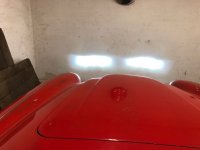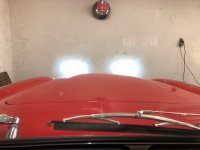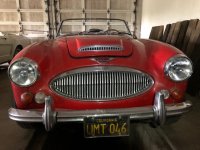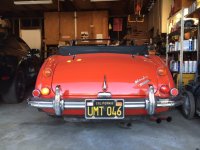-
 Hi Guest!
Hi Guest!
If you appreciate British Car Forum and our 25 years of supporting British car enthusiasts with technical and anicdotal information, collected from our thousands of great members, please support us with a low-cost subscription. You can become a supporting member for less than the dues of most car clubs.
There are some perks with a member upgrade!**Upgrade Now**
(PS: Subscribers don't see this gawd-aweful banner

Tips
- We have a special forum called "Member Articles" where you can submit actual articles for consideration for publication. Learn More
- Don't have an Avatar? If not, your avatar will default to the 1st character in your username. Go into "Account Details" to change your Avatar.
- Some basic forum navigation info: click
Hey - did you know if you click on the title of a thread it will take you to the first unread post since you last visited that thread?
- Hey Guest - Is your British Car Club in our Clubs database? If not, send me a PM - Basil

- Looking for a local club? Click the "Clubs" tab above and browse hundreds of clubs world-wide.
- Add Android or iPhone APP: click
- Did you know - any picture or video you add in your posts in any marque-specific forum will also get added to the Media Gallery automatically.
- A few more tips about posting and replying: click
- Hey there Guest - be sure to keep your profile page up to date with interesting info about yourself: learn more
- More tips and tricks on Posting and Replying: click
 STOP!! Never post your email address in open forums. Bots can "harvest" your email! If you must share your email use a Private Message or use the
STOP!! Never post your email address in open forums. Bots can "harvest" your email! If you must share your email use a Private Message or use the  smilie in place of the real @
smilie in place of the real @
- Want to mention another member in a post & get their attention? WATCH THIS

- So, you created a "Group" here at BCF and would like to invite other members to join? Watch this!
- Hey Guest - A post a day keeps Basil from visiting you in the small hours and putting a bat up your nightdress!
- Hey Guest - do you know of an upcoming British car event?
 Pretty Please - add it to our Events forum(s) and add to the calendar! >> Here's How <<
Pretty Please - add it to our Events forum(s) and add to the calendar! >> Here's How << 
- Hey Guest - you be stylin'
Change the look and feel of the forum to fit your taste. Check it out
- If you run across an inappropriate post, for example a post that breaks our rules or looks like it might be spam, you can report the post to the moderators: Learn More
- If you would like to try some different "looks" or styles for the site, scroll to the very bottom, on the left and click the Style Selector.
You are using an out of date browser. It may not display this or other websites correctly.
You should upgrade or use an alternative browser.
You should upgrade or use an alternative browser.
Generator or Alternator?
- Thread starter Wato
- Start date
Offline
For home lighting, an LED bulb uses a lot less power than incandescent. I would have thought the same was true for headlights. Not the case?My 100/4 Healey has a generator and I have fitted Electronic ignition. All runs well. Have been told I need to change to alternator if running at night and using the headlights which have been converted to LED. Any recommendations?
Bob_Spidell
Yoda
Offline
Maybe your source is confusing LED with halogen or HID (I'm being kind here)?
I put LED headlights on my BJ8. They were the whole bulb, inc. reflector, heat sink and lens. They are a bit brighter, the pattern is more squarish, and the color is a more bluish white than incandescents. The only thing I don't like is that the lens is flatter and doesn't go with the Healey's lines (but I can live with them). Where LEDs really, uh, 'shine' is for running/brake lights; I got tired of other drivers telling me my brake lights weren't working (at least partly because I don't accelerate into stoplights).
LEDs in the first image. Fourth pic is LED on the left, incandescent on the right; both are red (I think the LED 'overloaded' the camera).

LED Headlights Can Be Brighter but Often Lack Clear Advantages
Light emitting diode (LED) headlights are coming on more vehicles each year. Consumer Reports takes a look at this technology and explains that these lights may not be better than halogen lights.
www.consumerreports.org
I put LED headlights on my BJ8. They were the whole bulb, inc. reflector, heat sink and lens. They are a bit brighter, the pattern is more squarish, and the color is a more bluish white than incandescents. The only thing I don't like is that the lens is flatter and doesn't go with the Healey's lines (but I can live with them). Where LEDs really, uh, 'shine' is for running/brake lights; I got tired of other drivers telling me my brake lights weren't working (at least partly because I don't accelerate into stoplights).
LEDs in the first image. Fourth pic is LED on the left, incandescent on the right; both are red (I think the LED 'overloaded' the camera).
Attachments
Offline
Unless I'm missing something here ... if you're using LEDs, you're using much less current than the old incandescents. So changing from generator to alternator would prove no advantage in battery charging with regard to lighting needs. But alternators *always* charge your battery, regardless of engine speed (yep - even when idling). Generators don't charge the battery when the engine is running slowly.
Govtslug
Member
Offline
i switched to LEDs and they were rated at 65 watts (you can get some with a lower draw), which is pretty close to the draw from the old halogens I had in them. I think the LEDs require a lot of power for headlights. Taillights and marker lights will draw much less than the old incandescents and look much brighter. I‘m glad I switched to LED (much whiter and broader pattern), but total light is probably only slightly better and it didn’t help reduce the current draw much at all.
twas_brillig
Jedi Knight
Offline
Ideally, you should be able to compare current draw for the LEDs vs. the incandescents by checking the advertising/specifications. Also check with the source of the advice that the LEDs pull more current, as that is not my understanding.
Personally, I believe that - after seatbelts - the best modification you can do for any classic car is to switch to LEDs for brake/tail/signal lights. We've got LEDs for brake/tail on our BJ7 (and converted the reflectors to incandescent signal lights) plus also our son's early BMW 2002 has LED's (and that has made an incredible difference) and our (currently parked) BugEye.
Personally, I believe that - after seatbelts - the best modification you can do for any classic car is to switch to LEDs for brake/tail/signal lights. We've got LEDs for brake/tail on our BJ7 (and converted the reflectors to incandescent signal lights) plus also our son's early BMW 2002 has LED's (and that has made an incredible difference) and our (currently parked) BugEye.
Offline
I have LED headlights in my BN2 and run an alternator. I see no reason you would "need" to move to an alternator because of any LEDs. I switched to an alternator because I was tired of cracked mounting ears due to old parts (and no, my fanbelt was not too tight) , brush and commutator maintenance and the scenario of being on a trip with no spare. I can now get an alternator at most any car parts store. If you don't have your car in judged shows it is a very worthwhile upgrade in my book. Now you can even buy a dummy regulator with the needed internal changes to run an alt. Same sort of reasons I opted for a geared starter and run 2, 12V lawn tractor batteries in parallel, that I can get anywhere.
twas_brillig
Jedi Knight
Offline
We'ved stayed positive ground (perhaps should've changed, but the LEDs and their cost have us pretty much committed); we've also installed a "Dynamator" to keep the original look but to have the additional charging capability. Trivia: a generator will charge a flat battery (once youi're runninjg) whereas an alternator won't - according to my retired mechanic brother. The alternator is still the better long term choice, as it (previous remarked upon) it starts charging immediately.
Online
Alternator is more reliable. You don’t need to replace or gut the regulator, you just don’t need to connect the field wire.
Offline
Some folks, myself included, feel removing the regulator as no longer needed, is a bit much. I gutted mine so if for some strange reason I wanted to go back to a generator, all the original wires would be where they were and I'd just need my old regulator. I forgot to mention that although the regulators are generally reliable, the conversion does remove it from the spares kit I carry.
Bob_Spidell
Yoda
Offline
Trivia: a generator will charge a flat battery (once youi're runninjg) whereas an alternator won't - according to my retired mechanic brother.
More than trivia: " The alternator isn't designed to charge a dead battery. Premature alternator failure can occur and may Void Your Warranty"
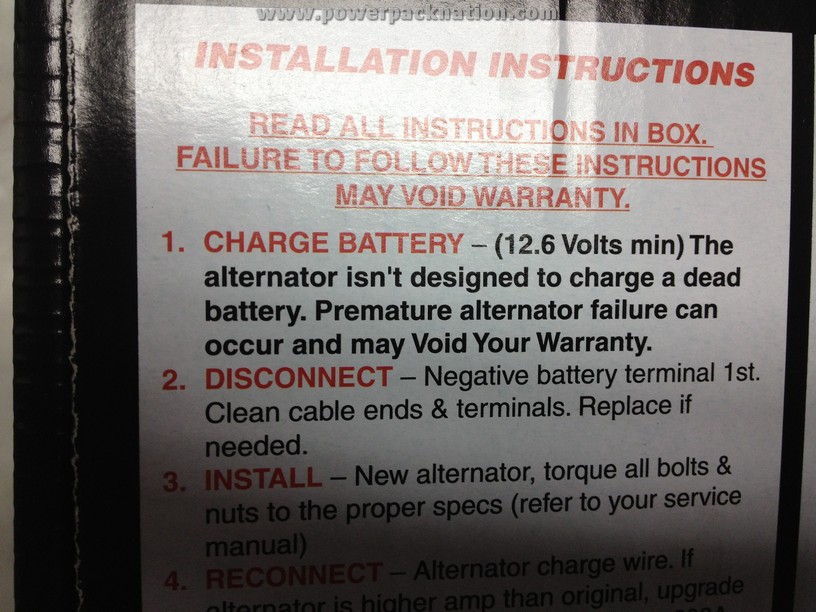
Fact: Alternators are not designed to charge dead batteries
Do you know the difference between jumper cables and an alternator? Your battery does!
www.optimabatteries.com
Hangtown Healey
Jedi Trainee
Offline
Judging from all the alternator failures on the Scandinavian 30-car Healey tour just completed, I will keep my generator, thank you very much.
Bob_Spidell
Yoda
Offline
Alternators should be at least as reliable as generators. Any commonality with all the failures?
I have changed all my globes over than the ignition light in the dash to LED more for the visibility to other drivers. With the electronic ignition and LED I figure I’m drawing far less power so I was a little surprised when told to upgrade to an alternator. I’ll keep running the generator at this stage. I feel a lot safer with Brightness of the LED but it does detract from the classic period look, having said that I’ve converted the rear reflectors to my indicators, separating them from the brake taillight original configuration on the BN1.Maybe your source is confusing LED with halogen or HID (I'm being kind here)?

LED Headlights Can Be Brighter but Often Lack Clear Advantages
Light emitting diode (LED) headlights are coming on more vehicles each year. Consumer Reports takes a look at this technology and explains that these lights may not be better than halogen lights.www.consumerreports.org
I put LED headlights on my BJ8. They were the whole bulb, inc. reflector, heat sink and lens. They are a bit brighter, the pattern is more squarish, and the color is a more bluish white than incandescents. The only thing I don't like is that the lens is flatter and doesn't go with the Healey's lines (but I can live with them). Where LEDs really, uh, 'shine' is for running/brake lights; I got tired of other drivers telling me my brake lights weren't working (at least partly because I don't accelerate into stoplights).
LEDs in the first image. Fourth pic is LED on the left, incandescent on the right; both are red (I think the LED 'overloaded' the camera).
Thanks for that info, I’m running a freshly rebuilt generator so at this stage will leave it, possibly consider an alternator if any emerging issues. I do take your point about easier replacements with the alternator. Some of the members in our club are running the alternators which look like the original generators.I have LED headlights in my BN2 and run an alternator. I see no reason you would "need" to move to an alternator because of any LEDs. I switched to an alternator because I was tired of cracked mounting ears due to old parts (and no, my fanbelt was not too tight) , brush and commutator maintenance and the scenario of being on a trip with no spare. I can now get an alternator at most any car parts store. If you don't have your car in judged shows it is a very worthwhile upgrade in my book. Now you can even buy a dummy regulator with the needed internal changes to run an alt. Same sort of reasons I opted for a geared starter and run 2, 12V lawn tractor batteries in parallel, that I can get anywhere.
Hangtown Healey
Jedi Trainee
Offline
The only common thing I am aware of is that those cars had electric fans.Alternators should be at least as reliable as generators. Any commonality with all the failures?
Bob_Spidell
Yoda
Offline
That shouldn't be an issue, as long as the alternator was rated for the total load plus a margin. I know rebuilt alternators are hit-or-miss, maybe some of the new ones too (built in you-know-where).The only common thing I am aware of is that those cars had electric fans.
Side note: I often wondered why my folks' 2000 Lincoln LS--with a 3.9L Jaguar engine--had a hydraulic cooling fan (using, essentially, a second power-steering pump). Finally found the answer in a Wikipedia article: The early models, 2000-2002 I think, didn't have a large enough alternator so they jury-rigged the hydraulic setup which, of course, has spawned at least one TSB (yep, the car overheated several times). Yay British engineering!
Online
Electric fans can take quite a bit of power. The running current on my 13" Spal is 22 - 23 Amps. Starting current is much larger, but the battery can provide some of that. When I installed AC, a 105-Amp alternator was specified because of the high draw of the high-speed AC blower and electric fan. I had to run a #6AWG cable from the alternator to a bus bar to supply those loads.That shouldn't be an issue, as long as the alternator was rated for the total load plus a margin. I know rebuilt alternators are hit-or-miss, maybe some of the new ones too (built in you-know-where).
Side note: I often wondered why my folks' 2000 Lincoln LS--with a 3.9L Jaguar engine--had a hydraulic cooling fan (using, essentially, a second power-steering pump). Finally found the answer in a Wikipedia article: The early models, 2000-2002 I think, didn't have a large enough alternator so they jury-rigged the hydraulic setup which, of course, has spawned at least one TSB (yep, the car overheated several times). Yay British engineering!


